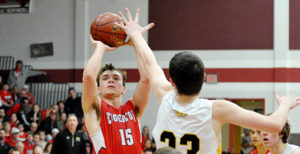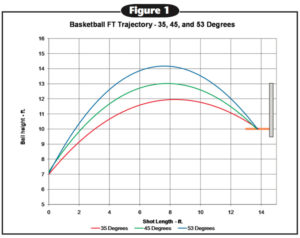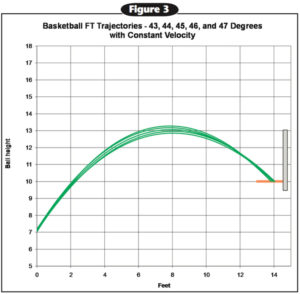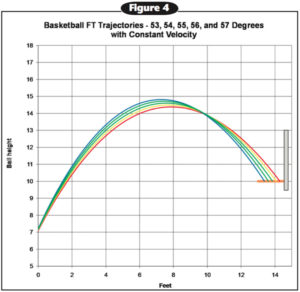Building the perfect arc in your shot
 Next time all of your players are in the gym, watch them as they shoot around. Don’t look at their mechanics, but rather look at the arc of their shot. Is the shot flat? Or does it seem to touch the clouds in an effort to bring rain down from the sky? Also, do your shooters have a consistent arc or are they just firing the ball at the rim at all angles?
Next time all of your players are in the gym, watch them as they shoot around. Don’t look at their mechanics, but rather look at the arc of their shot. Is the shot flat? Or does it seem to touch the clouds in an effort to bring rain down from the sky? Also, do your shooters have a consistent arc or are they just firing the ball at the rim at all angles?
For years, coaches have been trying to get their players to shoot with proper mechanics. But in reality, to turn a good shooter into a great shooter (or a mediocre one into a good one) an athlete must master the art of arc.
How do we know this? Experienced researchers at have been conducting studies for more than a decade to find the perfect angle and depth (into the rim) a shot should travel to score the most. Alan Marty, the founder of Noah Basketball, was the first to take on this challenge when he watched the best shooters in the world. Marty found that these shooters consistently appeared to have the same medium-height arc on their shots and shoot deep in the basket. But yet, most players haven’t figured this out, as statistics show that free-throw percentages at the NBA and NCAA level have not improved since 1958 (a steady 74% and 68% respectively).“There are thousands of coaches and shooting gurus who believe they know the answer to great shooting,” says Marty. “Then why, with so many experts available, has foul-shooting percentage remained constant in the NBA and NCAA?”
Identifying the problem

To reach a conclusion, Marty worked with the likes of Jerry Krause, the National Association of Basketball Coaches research chairman (who also currently served as Gonzaga University’s director of basketball operations); John Carter, now the CEO of Noah Basketball; and Dr. Tom Edwards, a NASA scientist. This team has spent years figuring out a substantive physics- and neuroscience-based method for players to make more shots.
Their conclusion is that an average shooter who shoots with an optimal arc of 45 degrees (give or take two degrees) is going to make about 11% more free throws than a shooter with a high arc of 53 degrees (68% vs. 57%). The same holds true going the other way. That same average 45-degree shooter makes 12% more free throws than a flat-arc 35-degree shooter (68% vs. 56%). FIGURE 1 shows what a 35- (red line), 45- (green line) and 53-degree (blue line) arc look like. (Click on images to enlarge).
For very skilled shooters, the same conclusion is found. A very skilled 45-degree-arc shooter averages a make-rate of 96%, while the 53-degree high arc shooter makes 89% and a 35-degree flat-arc shooter makes 80% of his or her free throws. Clearly, very skilled shooters make many baskets, but they could be making even more shots which is why this research is so critical.
“Sadly, most of the technology and shooting aids in basketball have been validated only by testimonials or someone’s opinion,” said Krause. “This is not the best validation of what works.”
“We are the first group to systematically and scientifically confirm what makes great shooters great,” Marty said.
In addition to the solid shooting mechanics taught by shooting coaches, players must also master these three shooting principles, according to Marty:
- All great shooters shoot the ball straight.
- All great shooters shoot the correct distance (11 inches beyond the front of the rim).
- And all great shooters shoot a consistent, medium height arc of 45 degrees.
Why 45 degrees?
Carter says he took a three-pronged approach to learning and testing the ideal shooting arc for basketball players, which consisted of the following:
1. What are the best shooters in the world shooting? Carter says the research team found out that some of the best shooters, including former NBA All-Stars Chris Mullin and Mark Price, consistently had their shot entry angle in the mid-40-degree range. To arrive at this conclusion, the company measured well over 10,000 shooters of all different ages and skill levels.
2. What did Dr. Tom Edwards find? Edwards is the director for aerospace at the NASA Ames Research Center. He earned his B.S.E. in Mechanical and Aerospace Engineering at Princeton University and holds a Ph.D. and M.S.E. degrees in Aeronautics and Astronautics from Stanford University. Edwards used a detailed mathematical model and determined that the best shooters would have an arc in the mid-40s.
3. What did the automated shooter find? The research team wanted to test Dr. Edwards’ computer models by shooting real basketballs at real hoops. They built an automated shooting machine that had a programmable shot height and skill level. The researchers programmed the machine to take 250 free throws at a 35-, 40-, 45-, 50- and 55-degree shot-entry level. The angle that made the most shots? You guessed it — 45 degrees.
Not just arc alone — distance too
 While researchers discovered the perfect arc for shooting, they also wanted to determine the best depth in the rim for making the most shots. Coaches always seem to be stressing to “swish everything,” but is that really the best way to instruct players? Carter emphatically says “no.”
While researchers discovered the perfect arc for shooting, they also wanted to determine the best depth in the rim for making the most shots. Coaches always seem to be stressing to “swish everything,” but is that really the best way to instruct players? Carter emphatically says “no.”
“Many players today simply do not shoot the ball deep enough in the basket,” Carter explains. “You don’t get an extra point for a swish. The research clearly finds that players who shoot the ball deeper in the basket make more shots. Watch some of the best shooters, and you’ll see they don’t always swish the ball. Instead, they often hit the back of the rim and score a BRAD shot, which stands for ‘Back Rim And Down.'”
Carter says specifically the spot where a player makes the most shots is when they average shooting 11 inches past the front of the rim. The diameter of a standard rim is 18 inches, so getting the ball two inches past the middle is ideal for shooters.

To get the ball two inches past the middle of the rim, shooters need to focus on their arc. Carter says high-arcing shooters generally are short when they miss, while line-drive shooters skew toward being too long on their shots (FIGURE 2).
Consistency is key
As with most things in the game of basketball, consistency is a major key in making shots. “An inconsistent shooter is never going to be great even if he or she averages a 45-degree arc and 11 inches in depth,” explains Carter.

An inconsistent shooter might average 45 degrees, but to do so that player ends up firing up a large number of high 55-degree shots as well as low 35-degree shots.
An inconsistent shooter also might average 11 inches of depth in a shot but, again, that only comes from shooting the ball well short and very long to come to the average.
“A great shooter only varies plus or minus two degrees on shot arc. If the shooter puts the same power behind the shot ,and it’s consistently in the mid-40-degree range, the ball is going to go the same distance,” says Carter. See FIGURES 3, 4, 5 and 6.

Chris Mullin shot 25 three-pointers for Noah Basketball research. He made 24 of those shots and his average angle of entry was 44.5 with a low of 43 and a high of 46. This is the kind of consistency that builds an NBA career in which he made more shots than he missed (Mullin had a field-goal percentage of 50.9% during his 16-year career) and knocked down 86.5% of his free throws.
The Noah System
“We found that the answer to great shooting proposed by Noah Basketball is validated,” Krause says. “First, we confirmed that all great shooters shoot the ball very straight seldom to the left or the right.
“Second, we confirmed that all great shooters shoot the correct distance (deep in the basket) with a good percentage of their made shots hitting the back of the rim before the ball scored. This was an unexpected revelation, because most coaches have been teaching that a swish is the best shot to practice. Third we confirmed that the very best shooters have a consistent medium-height arc.”
All of this research is great for coaches and players to know, but the question remains how do you actually figure out how to consistently shoot the ball with an entry angle in the mid-40s and a depth distance of 11 inches? During their quest for answers, the Noah team developed a machine (Noah Select System) that captures a player’s shot arc and shot distance.
When a player releases a shot, the Noah System’s “voice” instantly calls out a number signifying the arc of the shot. It’s at this point where players make their corrections. Once the Noah System calls out an arc number in the mid-40s, the player then works on the muscle-memory conditioning. After awhile, a player will get a feel for what a “45-degree shot” is like … and when a shot is too flat or high.
As soon as a player takes a shot, the information is transferred to a laptop computer where players can see their results at the end of a shooting session. The system charts the arc of multiple shots during a single session, which provides a good reminder of how important it is to maintain consistency.
Real-world results
Despite all of the scientific proof and available research data, sometimes coaches just need to hear from other coaches that an idea works to give that idea some merit. Several coaches were excited to discuss the benefits of the Noah research and the positive influence it has had on their teams, including the legendary Don Meyer.
“I wasn’t sure what to expect when we got the Noah machine, but we had a couple of players just wear it out that first year … and one of them ended up shooting 93% from the line that season,” said Meyer. “Knowing the research, it helped our players zero in on their arc and their distance. We ended up devising a charting system and recorded highs, lows and averages. We used that information to make up a point system based on distance and arc. It’s something we used in practice a lot, and the players really responded.
“It helped me too. After awhile I could stand on the sideline and see with the naked eye that a shot was going to be too low or too high.”
Bobby Luna, head boys basketball coach at Gallatin High School (Tennessee), said having accurate, reliable, immediate information has led to his team shooting much better this year compared to last.
“This generation wants immediate feedback. They also want visual feedback and this system does both. It’s the video-game age now so having a system available that generates immediate statistics is great,” Luna said. “Last year, before we learned about Noah’s research and system, we shot 58% from the free-throw line. This year, we advanced farther in the postseason tournament and ended the year shooting 74% from the line. One of our better players shot 87% from the line for the year, which was a school record. And, he made his first 30 free throws of the season.
“Eleven of our games came down to the last possession, even though we had less talent this year. There were several games where we had to make two free throws late in the game, and our players made them. Our players had a lot of confidence in their shots this year.”
Luna even mentions that his players were so into the arc numbers they would break their huddles at times and say “45” to symbolize that everyone remember to shoot at a 45-degree angle. “The players did not concentrate on making or missing their shots. They were thinking about the arc and the distance … and they ended up making a lot more this year.”
Kevin Richards, the girls varsity coach at Grosse Pointe South High School just outside of Detroit, said his players saw immediate positive results after learning about Noah’s research and using the system and that he had a “breakfast club” of four girls in the offseason who were running through workouts at 6 a.m. just to use the machine.
“The girls saw their stats and numbers increase so they bought into it,” says Richards. “We increased our scoring by 13 points per game from one season to the next once we figured out our proper shooting arcs and distances. We even had a sophomore who shot 52% from the free-throw line jump to 78% as a junior.”









